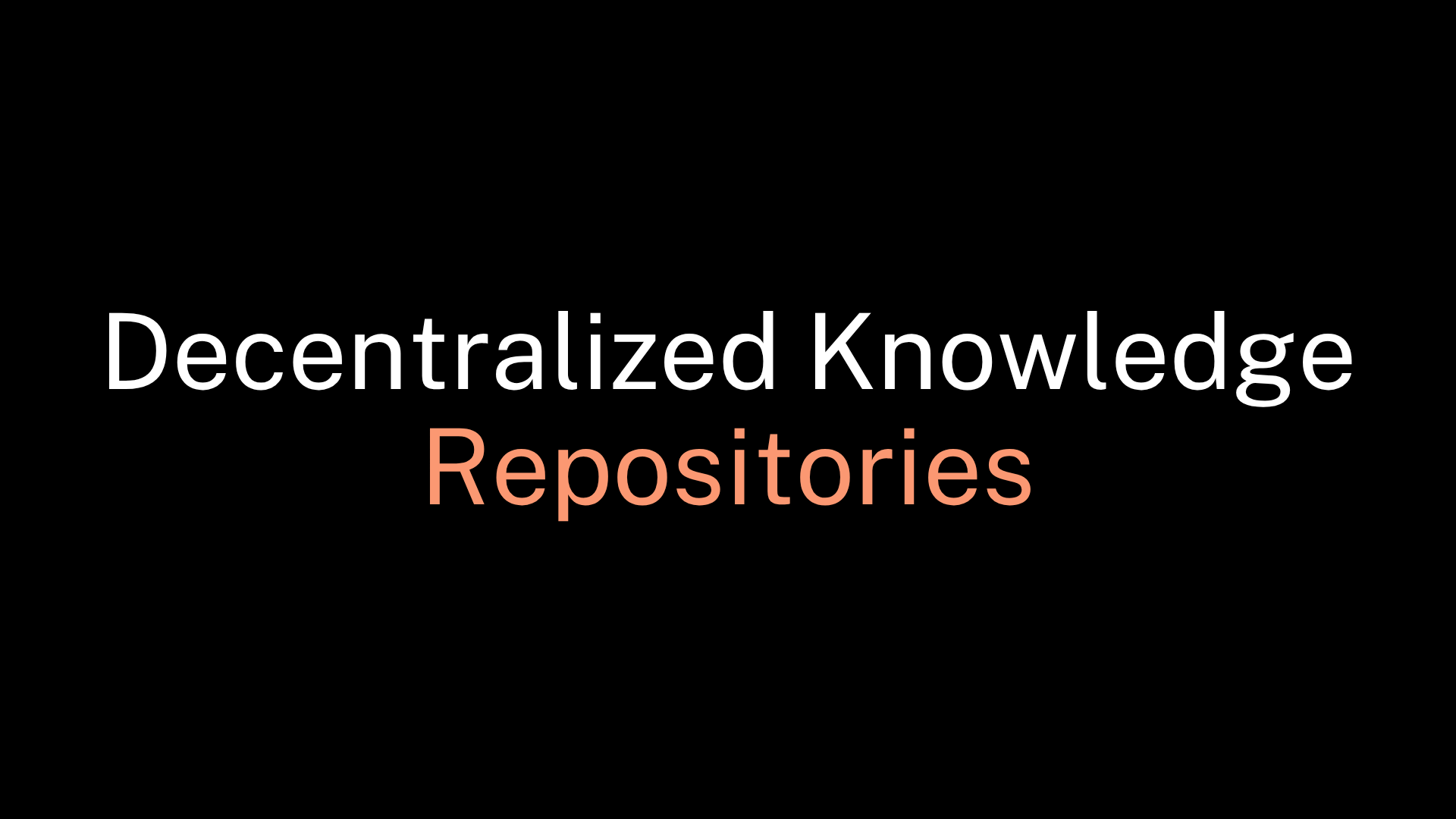Decentralized Knowledge Repositories

Traditionally, centralized platforms have controlled knowledge curation and distribution, often gatekeeping or monetizing access to information. In response, decentralized knowledge repositories (DKRs) have emerged as innovative alternatives, leveraging blockchain and distributed ledger technologies to ensure content resilience, fair access control, and contributor incentivization.
What Are Decentralized Knowledge Repositories?
Decentralized Knowledge Repositories are platforms or systems that allow users to store, access, and contribute to a collective body of knowledge without relying on centralized authorities. These systems utilize technologies such as IPFS (InterPlanetary File System), blockchain smart contracts, peer-to-peer networking, and decentralized identity frameworks to eliminate single points of failure or centralized control.
Examples include:
- Arweave: A blockchain-based permanent data storage solution.
- IPFS: A peer-to-peer distributed file system.
- Mirror.xyz: A decentralized publishing platform for Web3 creators.
- Kauri: A knowledge-sharing platform for the Ethereum community (now defunct but influential in early models).
Content Storage in DKRs
a. Distributed File Systems
At the heart of content storage in Decentralized Knowledge Repositories (DKRs) are technologies like IPFS and Filecoin. IPFS splits content into chunks, assigns each a unique cryptographic hash, and stores them across a peer-to-peer network. This not only ensures redundancy but also eliminates reliance on a central server.
- IPFS’s Deduplication and Versioning: Files are content-addressed, meaning identical files share the same hash, which saves space and enables version tracking.
- Arweave’s Permaweb: Unlike IPFS, Arweave aims for permanent storage by incentivizing long-term hosting through its native token (AR).
b. Immutable Content
Storing knowledge immutably ensures that once content is published, it cannot be changed or censored, an essential characteristic for preserving academic research, historical documents, or whistleblower content. This is achieved using blockchain anchoring or platforms like Arweave, which bundle data into blocks that are cryptographically validated and chained.
Access Control Mechanisms
Decentralized access control is crucial to ensure that while data may be publicly stored, access can be selectively granted or revoked based on programmable rules. DKRs typically implement access control through smart contracts, cryptographic primitives, and decentralized identity (DID) systems.
a. Smart Contract-Based Permissions
Smart contracts allow access rules to be codified on-chain. For example, a knowledge repository for medical research might require proof of credentials (via a decentralized credentialing system) to access certain content.
- Example: Lit Protocol offers programmable access control using blockchain-based conditions and encrypted content.
b. Zero-Knowledge Proofs (ZKPs)
ZKPs allow users to prove access rights without revealing sensitive data. For example, a user could demonstrate they hold a certain NFT or token granting access to a gated article, without exposing their wallet contents.
- Learn more about ZKPs from ConsenSys: https://consensys.net/blog/blockchain-explained/what-is-zero-knowledge-proof/
c. Decentralized Identity and Authentication
Access control becomes more sophisticated with DIDs (Decentralized Identifiers) and Verifiable Credentials (VCs). These allow users to authenticate without relying on centralized logins, enabling role-based or credential-based access to knowledge repositories.
- DID primer: https://www.w3.org/TR/did-core/
Incentivization Models
One of the revolutionary aspects of DKRs is the ability to financially or reputationally reward contributors, curators, and even readers. This ensures the ecosystem remains active, accurate, and up-to-date.
a. Token-Based Incentives: Platforms can issue native tokens to:
- Reward content creation
- Curate valuable contributions via DAO voting
- Fund peer review mechanisms
For instance:
- Mirror.xyz enables creators to monetize writing via crowdfunding or token-gated content.
- Arweave pays miners to host content permanently, funded by upfront payments from uploaders.
b. Reputation Systems: To maintain quality, DKRs often incorporate reputation systems that reward contributors based on community upvotes, citation frequency, or successful dispute resolution.
- Example: Kleros (https://kleros.io/) offers a decentralized arbitration protocol, allowing DKRs to implement community-based content moderation and reward mechanisms.
c. Data DAOs: Some repositories operate as Data DAOs, where a community collectively governs the curation and incentivization mechanisms. Participants may stake tokens to vote on what content to archive, highlight, or promote.
Use Cases of Decentralized Knowledge Repositories
a. Academic and Scientific Research: By ensuring immutability and verifiability, DKRs offer a superior alternative to traditional academic journals plagued by paywalls and central gatekeeping.
b. Cultural Heritage Preservation: Communities can use DKRs to preserve indigenous knowledge, folklore, language resources, and historical documentation in formats resistant to censorship or erasure.
c. Developer Documentation and Open-Source Collaboration: Tools like Radicle enable peer-to-peer code collaboration without relying on GitHub or similar centralized platforms, ensuring censorship resistance and persistent access.
d. Journalism and Whistleblowing: DKRs allow journalists to publish sensitive reports in a tamper-proof, censorship-resistant format, especially in politically repressive environments.
- Example: The Intercept’s use of SecureDrop (https://securedrop.org) could be further enhanced by decentralized storage systems.
Challenges and Considerations
Despite their promise, DKRs face several practical challenges:
a. Content Legality and Moderation: Immutability can become a double-edged sword if harmful, illegal, or false content is uploaded. DKRs must carefully balance freedom of information with ethical responsibilities.
b. Scalability and Cost: Permanent or distributed storage can be expensive and slow. Technologies like Filecoin and Layer-2 scaling solutions help mitigate these concerns, but performance is still a limitation.
c. Usability and Adoption: For non-technical users, DKRs may be daunting. Wallet management, token economics, and decentralized authentication often come with a learning curve. Improving UX is essential for mainstream adoption.
Conclusion
Decentralized Knowledge Repositories represent a bold reimagining of how humanity can store, access, and reward the distribution of information. By removing the centralized choke points and embedding incentives for transparency, these systems not only democratize access but create robust, tamper-resistant systems for preserving human knowledge.
References:
- IPFS – https://ipfs.tech
- Arweave – https://www.arweave.org
- Mirror.xyz – https://mirror.xyz
- Lit Protocol – https://litprotocol.com
- Kleros Arbitration – https://kleros.io
- Ocean Protocol & Data DAOs – https://blog.oceanprotocol.com/tagged/dao
- Verifiable Credentials – https://www.ibm.com/verify/digital-credentials
- Radicle for Decentralized Code Collaboration – https://radicle.xyz
MITOSIS official links:
GLOSSARY
Mitosis University
WEBSITE
X (Formerly Twitter)
DISCORD
DOCS
Comments ()